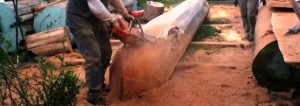June 8, 2012, Baclayon, Bohol, Pilipinas
It has been eight years since my last visit to the islands. I am back in the island of Bohol with inquiring heart and mind, empowerment vision of canoes in the waterways with singers and dancers to heal and protect our Mother Earth, a medicine dream team. Envisioning Pilipino/ Fil-Am contingent to pull from the San Francisco Bay Area from California!! Plan to be at the future canoe journeys in the pacific northwest, dreams of singing and dancing in the bangkas of the San Francisco Bay Area waterways…

Photo from Alexis Canillo. the Filipino-Pomo canoe that will join the Tribal Journey of canoes in the Pacific Northwest. The log was gifted by artist/activist L. Frank Manriquez via support from The Cultural Conservancy (http://www.nativeland.org/)
build a bangka (double sided outrigger canoe) / bigiw (single side outrigger canoe) from a log gifted to represent Filipinos, find a local skipper, build a bangka family for support, pullers to train and practice, raise awareness and educate about the islands’ diverse cultures among indigenous peoples of the turtle island. But first, start with my roots, the seafaring Bisayans. What are our traditions, prayers and chants for building, launching, welcoming, being in the canoe paddling on the water? This is a quest.
